New Dropshipping Strategy That Complies With Amazon’s Policy
Download Amazon Seller Guide
This guide will help you get started, understand the basics of Amazon selling, and explain in simple words how it all works.
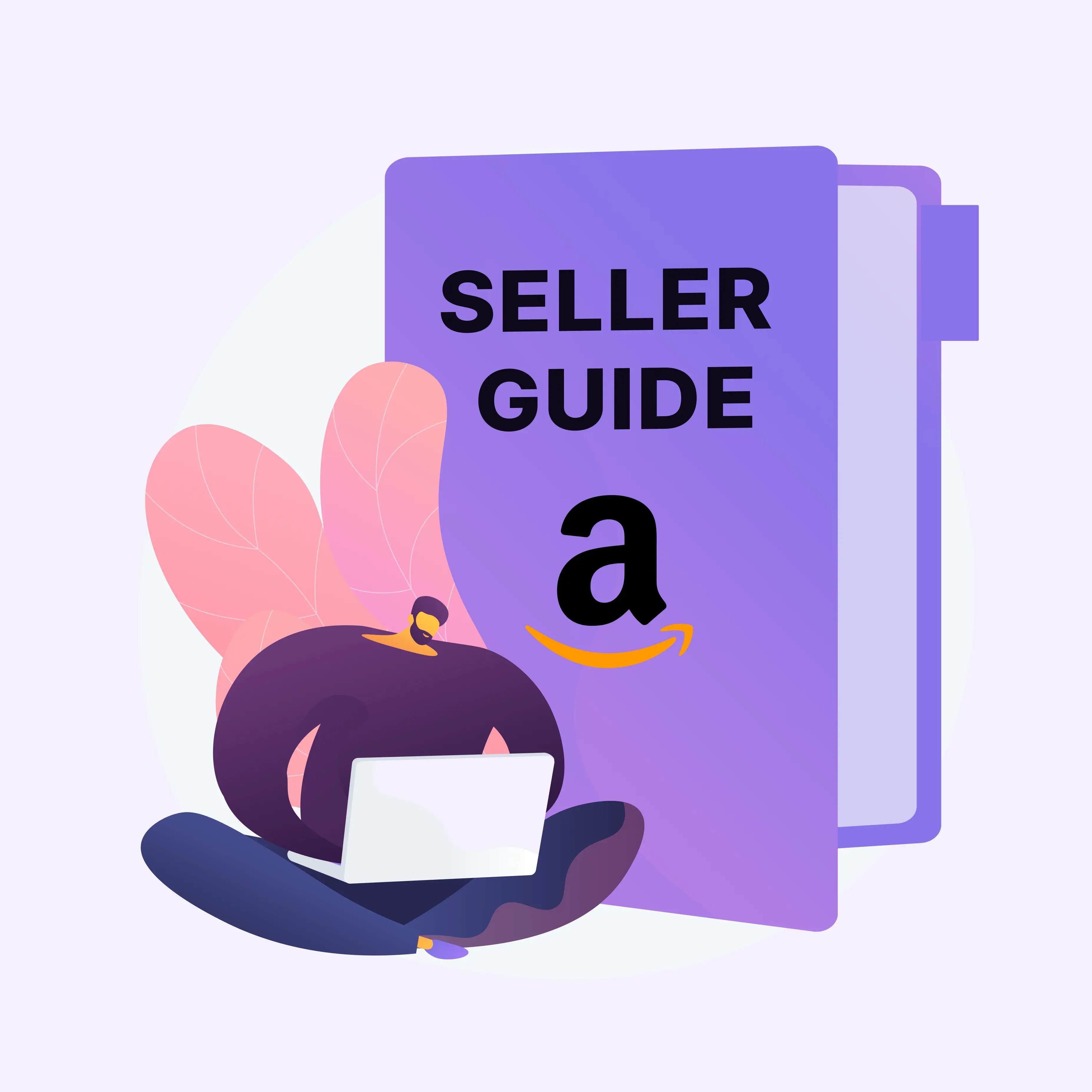
Dropshipping is a business model where the seller lists a product online, receives an order, and then has the supplier ship the item directly to the customer. It’s a lean, low-investment way to run an eCommerce business – and it’s allowed on Amazon, but only under strict conditions.
Amazon permits dropshipping only if you're the seller of record, and all invoices, packing slips, and shipping materials must identify you, not the supplier or another retailer. Sellers who ignore these rules – or rely on retail suppliers – often face account suspensions, listing removals, or outright bans.
But there’s a way to make dropshipping work safely and profitably within Amazon’s guidelines. In this post, we’ll introduce a new strategy that solves both compliance and margin challenges – step by step.
What Is Amazon Dropshipping?
%20(1).avif)
In theory, Amazon dropshipping is a simple, streamlined business model. You sell products on Amazon without storing inventory or handling fulfillment yourself. Instead, you make an agreement in advance with a third-party supplier who stocks the items. When a customer places an order and pays you, you then purchase the product from the supplier – who ships it directly to the customer.
It sounds efficient: you don’t hold stock, you don’t pay for products upfront, and you avoid the hassle of shipping. The profit comes from the price difference between your Amazon listing and what the supplier charges.
If done correctly, this model should allow sellers to build a low-cost, scalable business – especially if they can find reliable suppliers and high-margin products.
Why Traditional Dropshipping Fails on Amazon?
While the theory makes sense, the real-world execution often breaks Amazon’s rules. Amazon does allow dropshipping, but only under strict conditions outlined in its dropshipping policy.
According to Amazon, you must do the following.
Amazon dropshipping policy
- Be the seller of record for the product.
- Ensure that your name or business is on all invoices, packaging slips, and external documentation included in the order.
- Remove any branding or identification from third-party suppliers or manufacturers that might mislead the customer.
- Be fully responsible for accepting and processing returns.
- Comply with all Amazon’s selling policies and guidelines.
What’s not allowed
- Having another retailer fulfill your orders (e.g., buying from Walmart and shipping it directly to Amazon customers).
- Sending packages that include third-party logos, invoices, or packing slips.
- Appearing to be a “middleman” rather than the actual seller.
Violating these rules can lead to serious consequences – account suspension, listing deactivation, or even a permanent ban.
This is why traditional dropshipping methods, especially those relying on retail suppliers, are often not compliant with Amazon’s standards. But, as you'll see in the next sections, there’s a strategy that does work – and keeps your business safe.
Example. If you find a cheaper-priced product on Target and list it on Amazon, it’s strictly forbidden to have Target send it directly to the shopper with Target’s packing slips and the external packaging.
Amazon explains that if a customer sees packaging, invoices, or receipts identifying a seller that doesn’t belong to Amazon, that creates confusion for the shopper. In such a case, the buyer is confused about how their order is being fulfilled and whom they should contact with any problems or questions.
Amazon can remove your selling privileges if you fail to observe their dropshipping policy.
Why Most Dropshippers Struggle on Amazon: The 3 Big Challenges

Dropshipping may seem simple, but most Amazon sellers quickly discover that the traditional approach doesn't hold up. Beyond the appeal of not managing inventory, the model is filled with pitfalls that can jeopardize your profits – and your seller account. Here are the three core challenges Amazon dropshippers face.
Razor-thin margins and price wars
Many dropshippers rely on retail suppliers with prices that leave little room for profit once Amazon’s fees and shipping costs are factored in. With hundreds of sellers listing the same generic products, you’re forced into a race to the bottom – where even small profits become hard to sustain.
Violating Amazon’s dropshipping policy
Amazon enforces strict rules: you must be the seller of record, and your shipments must include only your branding – no third-party logos, invoices, or marketing materials. Dropshippers using retailers or unvetted suppliers often violate these terms unknowingly, triggering account suspensions or permanent bans.
Finding profitable, low-risk products
Identifying winning products that are both profitable and policy-safe is harder than it looks. Many sellers waste time on low-demand items or get penalized for selling restricted or IP-protected products. Without the right tools or sourcing strategy, finding the right deals can be overwhelming and ineffective.
A New Dropshipping Strategy that Complies with Amazon’s Policy
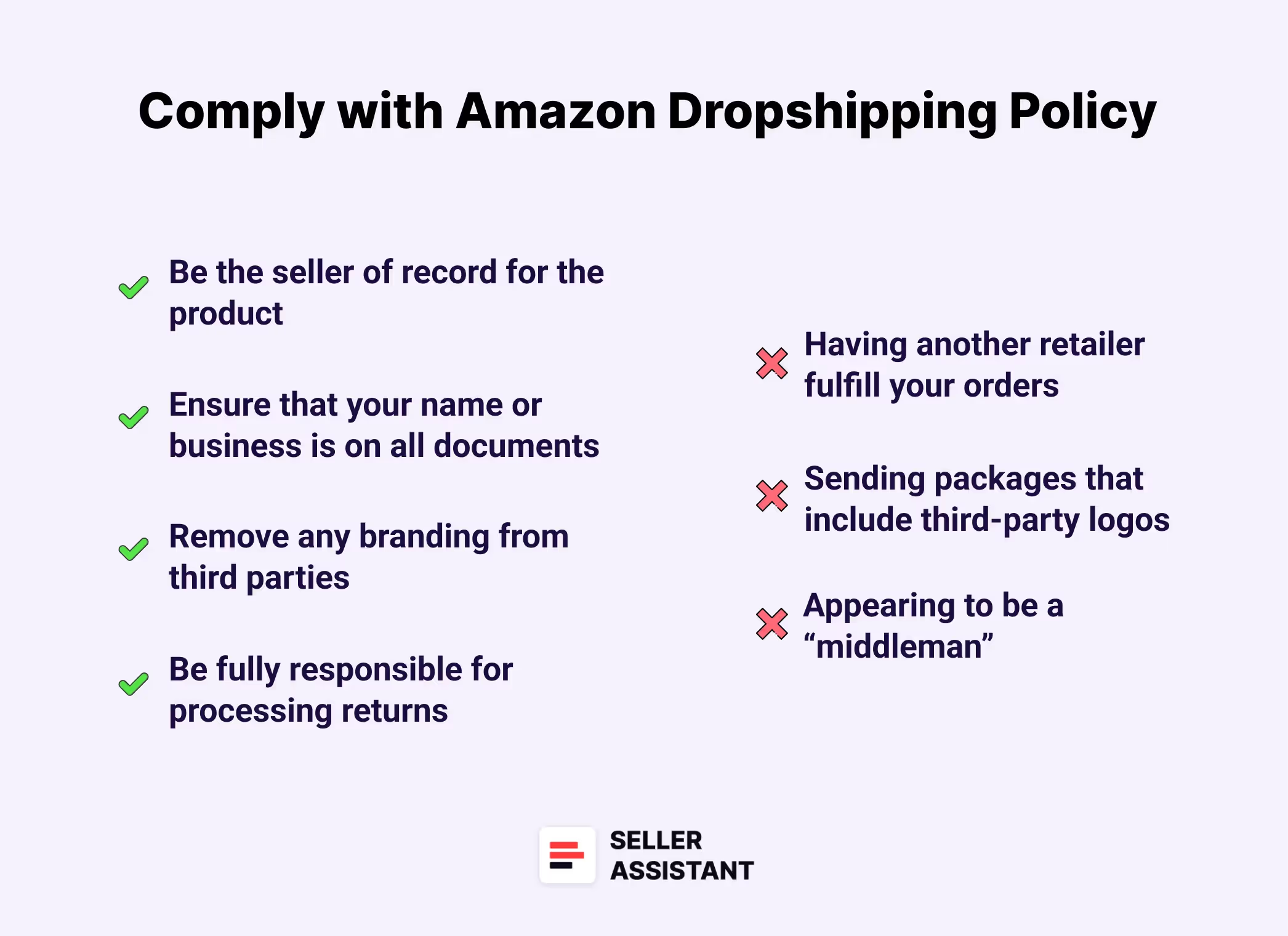
This innovative dropshipping strategy is designed to solve two of the biggest challenges Amazon sellers face: struggling to find profitable products and staying compliant with Amazon’s dropshipping policy.
Rather than relying on searching single leads – which eats up enormous time – you parse supplier websites, automate product analysis to identify high-margin deals, set average price to avoid price wars, wait until the offer sells, and fulfill orders through a prep center to meet Amazon’s compliance requirements.
How It works
Begin by choosing a supplier from Seller Assistant’s List of 500+ US suppliers. Use a web scraping tool to extract product data directly from the supplier’s website. Upload this data to Seller Assistant’s Price List Analyzer, which automatically matches items to Amazon listings and evaluates them for profitability, compliance risks, and sales performance.
Filter and analyze the list to find 50–100+ winning products. List your offers by joining existing Amazon listings and pricing your items just above the average Buy Box price (about 1–1.5%). You don’t buy or ship anything until an item sells, giving you time to research more deals. Once an order is placed, purchase the product from your supplier and send it to a prep center. The prep center rebrands the item and forwards it to the customer, ensuring compliance with Amazon’s dropshipping policy.
What is achieved
This strategy offers full compliance with Amazon’s rules by ensuring
- You're always the seller of record.
- All shipments are free of supplier branding, invoices, or marketing.
- You remain in control of your customer’s buying experience.
- More importantly, sellers can easily identify a large volume of profitable deals using automation – deals with better margins than the over-saturated, price-war listings common in traditional dropshipping. This opens the door to a sustainable, scalable business model.
Tools to use
- Seller Assistant’s List of 500+ US suppliers
A curated directory of vetted suppliers, offering a solid foundation for dropshipping without policy violations. These sources are reliable, professional, and optimized for long-term Amazon success.
Seller Assistant’s Price List Analyzer
Price List Analyzer is the engine behind your product analysis. It automates large-scale sourcing and turns raw supplier lists into actionable Amazon leads.
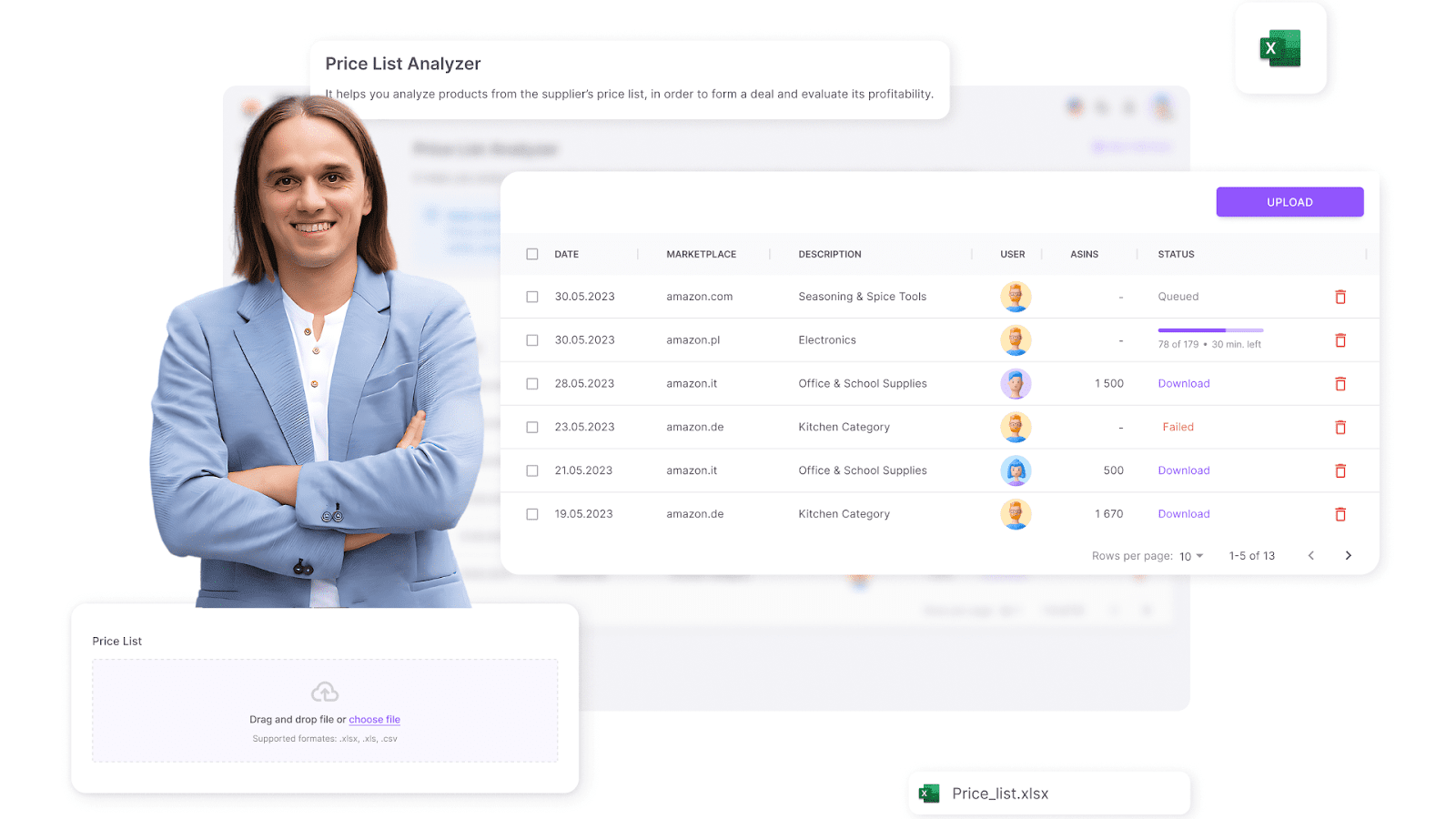
Price List Analyzer helps you
- Automatically match supplier products to their Amazon ASINs.
- Check if a product is sellable on your account and review restrictions.
- Add essential sourcing metrics like profitability and risk to your spreadsheets.
- Bulk-analyze supplier lists to quickly spot high-ROI deals.
- Get detailed performance data: potential profit, sales volume, and velocity.
- Dive into profitability metrics like profit, ROI, margin, break-even point, and estimated sales to uncover high-margin deals.
- Evaluate competition by checking FBA and FBM offers.
- Track Buy Box averages and pricing trends across 30, 90, and 180 days.
- Uncover sourcing risks: product restrictions, IP complaints, listings with Amazon in the Buy Box, warnings and risks (hazmat, fragile, meltable, etc.).
- Filter by profitability, restrictions and risks, sales performance, Buy Box price, and competition levels, to refine your sourcing strategy.

Note. Seller Assistant is a comprehensive product-sourcing software that helps Amazon sellers quickly find high-profit deals. It combines three extensions: Seller Assistant Browser Extension, and IP-Alert Chrome Extension by Seller Assistant, and VPN by Seller Assistant, Amazon seller tools: Price List Analyzer, Brand Analyzer, Seller Spy, Bulk Restrictions Checker, and API integrations, and features: Side Panel View, FBM&FBA Profit Calculator, Quick View, ASIN Grabber, UPC/EAN to ASIN converter, Stock Checker, IP Alert, and Restrictions Checker.
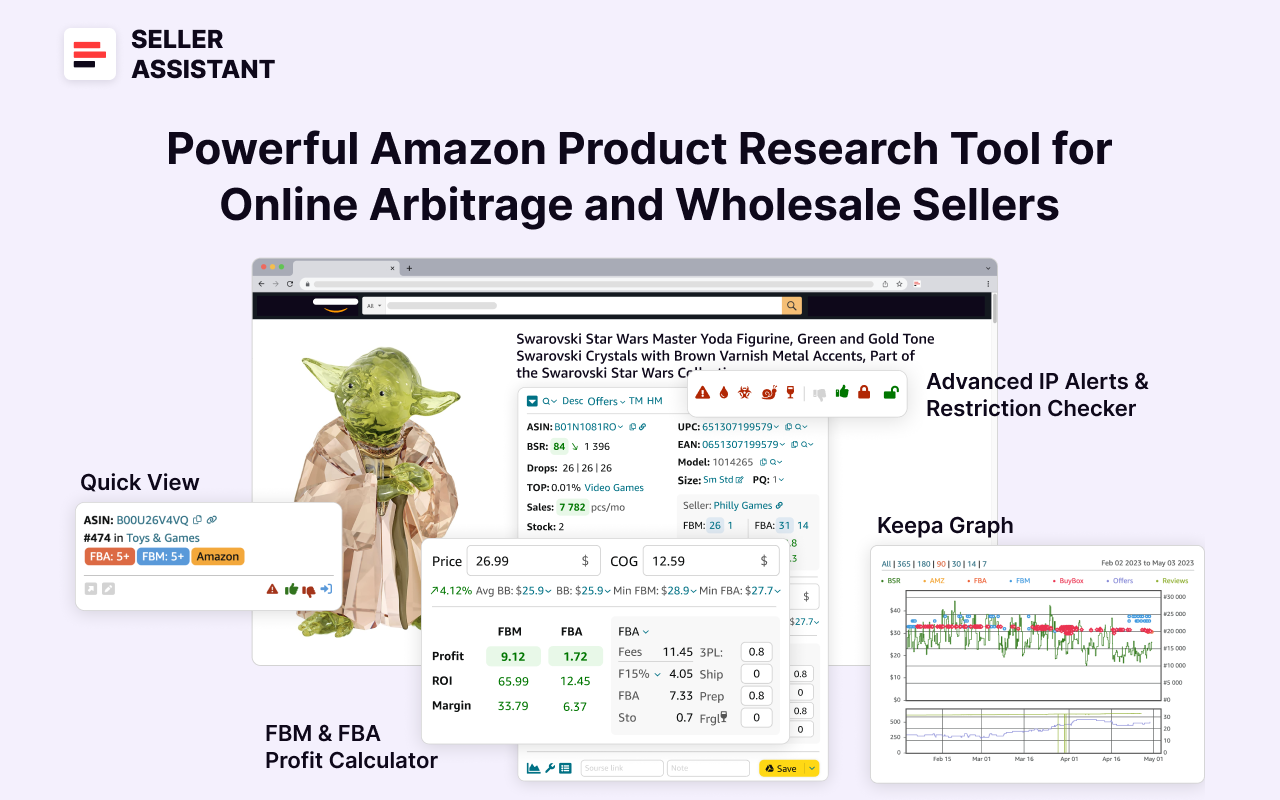
Seller Assistant shows all essential product data on Amazon search, product, and inventory pages, on supplier websites, and your competitor storefronts to help you find high-margin deals. By using this FBA and FBMproduct sourcing software, you can easily identify products that have the potential to be sold well on Amazon.
How the Strategy Works: Step-by-Step
Dropshipping on Amazon is full of potential – but also full of pitfalls. Most dropshippers struggle with two core issues:
- Finding profitable products with strong margins
- Staying compliant with Amazon’s dropshipping policy, which prohibits being seen as a reseller for another retailer.
This strategy solves both challenges through a smart combination of vetted suppliers, automation tools, and prep center compliance. Here’s how it works in six streamlined steps.
Step 1. Choose a vetted U.S. supplier
Start by selecting a reliable supplier from Seller Assistant’s List of 500+ US suppliers. These suppliers are carefully vetted to ensure they meet professional standards – just consistent supply ready for compliant fulfillment.
Step 2. Scrape the supplier’s product data
Use a web scraping tool to collect product information directly from the supplier’s website. This gives you a bulk list of potential products – complete with pricing, SKUs, and descriptions – ready to be analyzed for Amazon potential.
Step 3. Upload to Price List Analyzer and evaluate deals
Upload your scraped product data into Seller Assistant’s Price List Analyzer. The tool automatically matches each product to its Amazon ASIN, fills in crucial data like profitability, sales velocity, restrictions, and risks – then lets you apply filters to find high-ROI, low-risk, best-selling deals.
Step 4. Expand product sourcing across multiple suppliers
Repeat this process across several suppliers. You’ll quickly build a shortlist of 50 to 100+ winning products, creating a scalable product pipeline filled with items that are not only profitable but also policy-compliant.
Step 5. List offers on Amazon and set smart pricing
Add your offers to existing Amazon listings. Set your prices around 1–1.5% higher than the average Buy Box price to stay competitive while giving yourself some margin flexibility. Since you don’t buy inventory upfront, you can keep expanding your catalog while you wait for sales to come in.
Step 6. Fulfill orders through a prep center
Once a product sells, order it from your supplier – but have it shipped to a prep center instead of directly to the customer. The prep center removes all third-party branding, repackages the item, and ships it in your name. This ensures full compliance with Amazon’s policy, keeps you as the seller of record, and protects your account from suspension.
What Makes a Good Dropshipping Deal?
To succeed with dropshipping on Amazon, your product must meet three essential criteria: it should have strong demand, offer healthy profit margins, and pose minimal risk. But picking any trending item and listing it isn’t enough.
A reliable dropshipping product must check several specific boxes – ranging from eligibility and profitability to sales velocity, Buy Box behavior, and compliance factors. Below are the core areas to evaluate when identifying a worthwhile product for your dropshipping business.
Sellability and listing eligibility
First, make sure the product is eligible for sale on your Amazon seller account. Some categories, brands, or products are gated or restricted – especially for new or low-performance accounts.
Before researching anything, check whether you can list the product. This prevents wasted time and avoids situations where Amazon blocks your listing or asks for approval documents.
Profit potential and cost structure
You must calculate whether the product will deliver the profit you expect. In dropshipping, profit is the amount left after subtracting your supplier cost, Amazon fees, and third-party logistics (prep center) costs from the selling price.
Analyze both ROI and margin to ensure you're not working with razor-thin profits that can be wiped out by slight price shifts.
Profitability metrics overview
- Profit
The net amount earned after deducting costs like COGS, Amazon referral fees, and prep center fees.
- ROI (Return on Investment)
Shows your return as a percentage of the investment. A good dropshipping ROI starts around 15–30%.
- Margin
Reflects profit as a percentage of the selling price. A healthy Amazon margin is typically 10% or more.
Sales performance and demand
To avoid sitting on inactive listings, analyze how well a product sells. You need both a solid sales history and a fast sales velocity to ensure your offers generate regular income.
Key demand indicators
Indicates how well a product sells within its category. A lower BSR generally means higher demand.
- BSR drops
Count how many times the BSR dropped over a given period to estimate actual units sold.
- Sales velocity (Top in Price List Analyzer)
Measures how quickly an item sells. Low velocity suggests poor demand, which can slow your growth and tie up resources.
Competitive landscape
Analyze how intense the competition is for each product. Too many sellers can lead to aggressive price cutting, shrinking your margins and making the product unsustainable.
Evaluate how many FBA and FBM sellers are offering the same product. If Amazon is also selling it directly, consider skipping it – it’s hard to beat Amazon in price and delivery terms.
Competition insights
- Multiple sellers
Products with 3–15 sellers are often safer and indicate resell-friendly listings.
- One seller
If only one seller exists and the brand matches the seller name, it’s likely a private label item – off-limits for dropshippers.
Buy Box behavior and competition
The Buy Box is critical – over 80% of Amazon sales go through it. You must understand how it's shared, who wins it most often, and whether there's room for new sellers.
If the Buy Box is dominated by a single seller or by Amazon, it's hard to get the Buy Box share. However, Buy Box listings evenly shared among multiple sellers can be great opportunities.
Buy Box evaluation
- Buy Box %
Shows how often each seller wins the Buy Box. Shared percentages indicate fair rotation and better entry chances.
Sales volume estimation
Estimate how many units you can realistically sell each month. This helps you prioritize higher-performing listings and manage supplier relationships efficiently.
Understanding volume also helps decide how many product offers you need to list to generate meaningful income.
Product restrictions and compliance
Amazon prohibits selling some items without approval. These restrictions apply to entire categories, specific brands, or certain high-risk products.
Check if your chosen item is gated before listing. If it is, you’ll need to either request approval or move on to another product. Approval might require invoices and documentation – which isn't compatible with lightweight dropshipping strategies.
Intellectual property complaint risk
Selling branded products without authorization is risky. Some brands file IP complaints if unauthorized resellers list their products – even if you acquired them legally.
If a product or brand has a history of IP claims, it’s better to avoid it unless you have the brand’s permission. IP complaints can lead to suspended listings or even account deactivation.
Hidden risks and product complications
Some products may seem perfect but come with complications like special handling, higher fulfillment fees, or regulatory limits. Always account for product type before listing.
Common risks in dropshipping
- Amazon as a seller
If Amazon owns the listing, consider skipping it.
Requires approval; involves products like batteries and chemicals.
Require category approvals.
- Generic brand
You might not be allowed to join listings if the brand is marked as generic or is blocked.
Pricing and market positioning
You must price your offers competitively to win the Buy Box. Study historical pricing trends and behavior to avoid listings with unstable prices and price wars.
Price behavior analysis
- Average Buy Box price
Indicates the fair market value over time.
- Buy Box trend
See if pricing is rising, falling, or flat (over 30, 90, and 180 days).
Variation analysis
For listings with multiple product variations (e.g., sizes, colors, styles), not all variations perform equally. You should list the variation with the highest demand.
Use rating share percentages to spot the top-selling variant. The best-seller has the biggest share. This helps you avoid listing slow movers and increases your chance of consistent sales.
FAQ
Is dropshipping allowed on Amazon?
Yes, Amazon allows dropshipping, but only if you follow its strict policy. You must be the seller of record, and no third-party branding can appear on the product, invoice, or packaging.
What happens if I use retail suppliers for dropshipping?
Using retail suppliers often violates Amazon’s dropshipping policy, as packages may include their branding or slips. This can result in account suspension or a permanent ban.
What’s the best way to find profitable dropshipping products?
Use tools like Seller Assistant’s Price List Analyzer to bulk-scan supplier data and identify high-ROI, low-risk products. Automation helps avoid manual errors and speeds up product research significantly.
What is a prep center and why do I need one?
A prep center is a third-party service that receives products from your supplier, removes any branding or retail packaging, and ships the item to the customer in your name. It’s essential for maintaining compliance with Amazon’s dropshipping rules.
How many products do I need to list to make consistent income?
You’ll typically need to list at least 50 to 100 profitable, low-risk products to generate steady sales. The more well-researched listings you have, the more likely you are to earn consistently.
Final Thoughts
Amazon dropshipping doesn’t have to be risky or complicated – if you follow the right strategy. By sourcing from vetted suppliers, using automation to uncover profitable products, and routing shipments through a prep center, you can build a fully compliant, scalable business.
This modern approach solves the biggest pain points of traditional dropshipping: policy violations, thin margins, and unreliable fulfillment. With ultimate Seller Assistant's tools and workflow, you can focus on growth, not guesswork. This strategy is your blueprint.
Seller Assistant is an all-in-one product sourcing software offering all the features vital for product sourcing. It combines three extensions: Seller Assistant Extension, IP Alert, and VPN by Seller Assistant, tools: Price List Analyzer, Brand Analyzer, Seller Spy, Bulk Restrictions Checker, and API integrations, and features: Side Panel View, FBM&FBA Profit Calculator, Quick View, ASIN Grabber, UPC/EAN to ASIN converter, Stock Checker, and other features that help quickly find high-profit deals. Seller Assistant also offers integration with Zapier allowing to create custom product sourcing workflows.
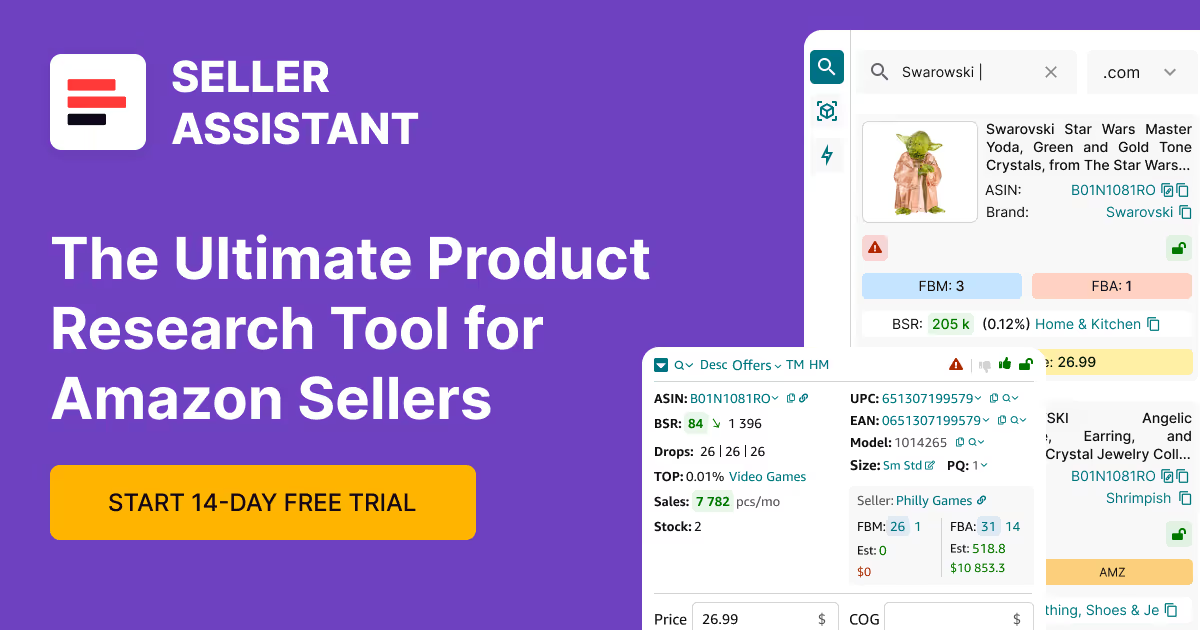
.svg)













